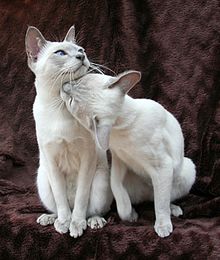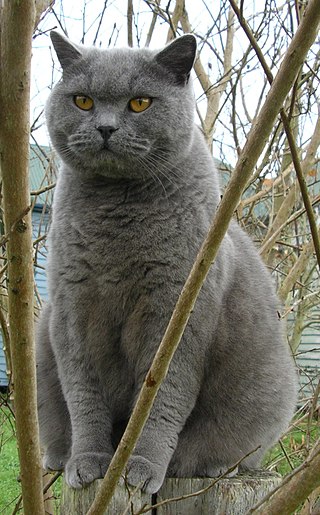
The British Shorthair is the pedigree version of the traditional British domestic cat, with a distinctively stocky body, thick coat, and broad face. The most familiar colour variant is the "British Blue", with a solid grey-blue coat, pineapple eyes, and a medium-sized tail. The breed has also been bred in a wide range of other colours and patterns, including tabby and colourpoint.
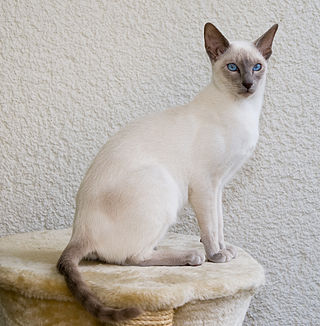
The Siamese cat is one of the first distinctly recognised breeds of Asian cat. It derives from the Wichianmat landrace. The Siamese cat is one of several varieties of cats native to Thailand. The original Siamese became one of the most popular breeds in Europe and North America in the 19th century. Siamese cats have a distinctive colourpoint coat, resulting from a temperature-sensitive type of albinism.

The Russian Blue cat, commonly referred to as just Russian Blue, is a cat breed with colors that vary from a light shimmering silver to a darker, slate grey. The short, dense coat, which stands out from the body, has been the breed's hallmark for more than a century.

The Ocicat is an all-domestic breed of cat which resembles a wild cat but has no recent wild DNA in its gene pool. It is named for its resemblance to the ocelot. The breed was established from the Siamese and Abyssinian and later on American Shorthair would be added.

The Somali cat is genetically similar to the Abyssinian cat. Due to inheriting 2 copies of the recessive gene for long hair, they have a characteristic luscious coat, unlike their cousin the Abyssinian.

Nakhon Ratchasima is one of Thailand's seventy-six provinces (changwat) lies in lower northeastern Thailand also called Isan. It is the country's largest province by area, has a population of approximately 2.7 million, and generates about 250 billion baht in GDP, the highest in Isan. Neighbouring provinces are Chaiyaphum, Khon Kaen, Buriram, Sa Kaeo, Prachinburi, Nakhon Nayok, Saraburi, and Lopburi.

The Burmese cat is a breed of domestic cat, originating in Burma, believed to have its roots near the Thai-Burma border and developed in the United States and Britain.

The Havana Brown was the result of a planned breeding between Siamese and domestic black cats, by a group of cat fanciers in England, in the 1950s. Early breeders introduced a Siamese type Russian Blue into their breeding. However, using current genetic testing, it is believed that almost none remain in the gene pool.
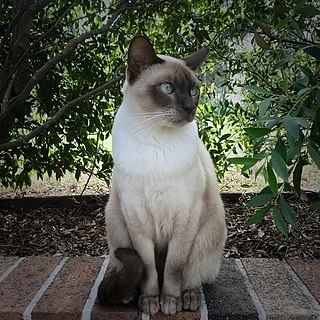
Tonkinese is a domestic cat breed produced by crossbreeding between the Siamese and Burmese. Members of the breed are distinguished by a pointed coat pattern in a variety of colors. In addition to the modified coat colors of the "mink" pattern, which is a dilution of the point color, the breed is now being shown in the foundation-like Siamese and Burmese colors: pointed with white and solid overall (sepia).

The Oriental Shorthair is a breed of domestic cat that is developed from and closely related to the Siamese cat. It maintains the modern Siamese head and body type but appears in a wide range of coat colors and patterns. Like the Siamese, Orientals have almond-shaped eyes, a triangular head shape, large ears, and an elongated, slender, and muscular body. Their personalities are also very similar. Orientals are social, intelligent, and many are rather vocal. They often remain playful into adulthood, with many enjoying playing fetch. Despite their slender appearance, they are athletic and can leap into high places. They prefer to live in pairs or groups and also seek human interaction. Unlike the breed's blue-eyed forebear, Orientals are usually green-eyed. The Oriental Longhair differs only with respect to coat length.

The Siberian is a centuries-old landrace of domestic cat in Russia, and recently developed as a formal breed with standards promulgated the world over since the late-1980s. Since 2006, the breed is recognised for registry and championship status with all major cat registries.

The Snowshoe is a rare breed of domestic cat originating in the United States of America in the 1960s. The Snowshoe is a short-haired bicolour colourpoint breed. Snowshoes were first produced when a Siamese breeder's cat gave birth to three kittens with white feet. The breeder, Dorothy Hinds-Daugherty, then began a breeding program to produce what were originally called "Silver Laces", crossing the strangely marked Siamese cats with bicolour American Shorthair cats and other breeds. Despite having existed for 45 years, Snowshoes are rare due to the difficulty of reproducing the correct coat markings.

The Oriental Longhair is a variety of domestic cat closely related to the Oriental Shorthair. The Oriental Longhair in some registries, such as The International Cat Association (TICA), it is considered a separate breed. In others, such as the Cat Fanciers' Association (CFA), it is a division, along with the short-haired variety, of a merged breed, the Oriental. With no globally recognised naming convention, other cat fanciers may refer to this type as Foreign Longhair, Javanese or Mandarin. It was formerly known as the British Angora before being renamed in 2002 by British cat fanciers in order to avoid confusion with the Turkish Angora.

The Colorpoint Shorthair is a variety of Siamese cat. The only major registries to recognise them are the Cat Fanciers' Association (CFA) and the World Cat Federation (WCF). This breed was established from breeding American Shorthairs with the Siamese to produce different point colors, beyond the four standard Siamese colors.

The Thai or Wichien Maat is a newly renamed but old cat breed, related to but different from the Western, modern-style Siamese cat. This natural breed is descended from the cats of Thailand, and, among various groups of breeders in different times and places, has also been called the Old-Style Siamese, Traditional Siamese, Classic Siamese; Wichien Maat ; and the Applehead, a nickname that originated in the 1950s. According to The International Cat Association: "The Thai is the breed dedicated to preserving the native pointed cat of Thailand in as close to its original form as possible."

An Oriental bicolour is any cat of Oriental type, either long-haired or short-haired and in any pattern including colourpoint, which has white areas on its coat caused by the white spotting gene. In most cat fancier and breeder organisations, Oriental bicolours do not constitute a standardised breed, but a coat pattern variant of the breed of their foundation stock. One breed registry is an exception, the UK-based Governing Council of the Cat Fancy (GCCF), which has defined them as a separate breed named Oriental Bicolour (capitalised).

Nakhon Ratchasima Football Club, is a Thailand professional football club based in the province of Nakhon Ratchasima, Thailand. They currently compete in the Thai League 1 in the 2024–25 season, following promotion from the 2023–24 Thai League 2 as champions.
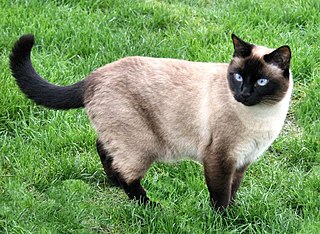
Acromelanism is a genetic condition that results in pigmentation being affected by temperature. It results in point coloration where the extremities of an animal are a different colour to the rest of the body. It is commonly known for the coloration of Siamese and related breeds of cat, but can be found in many other species including dogs, rabbits, rats, mice, guinea pigs, minks, and gerbils. It is a specific type of point coloration.
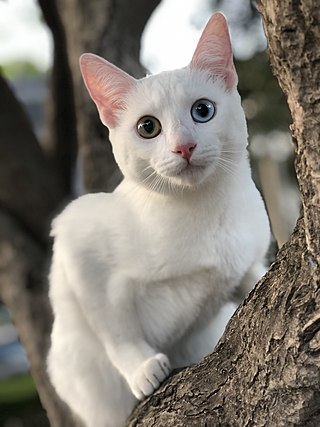
The Khao Manee cat, or Khao Plort, also known as the Diamond Eye cat, is a rare, natural breed of domestic cat originating in Thailand, which has an ancient ancestry tracing back hundreds of years. They are mentioned in the Tamra Maew. Khao Manee cats are short-haired solid-white cats.
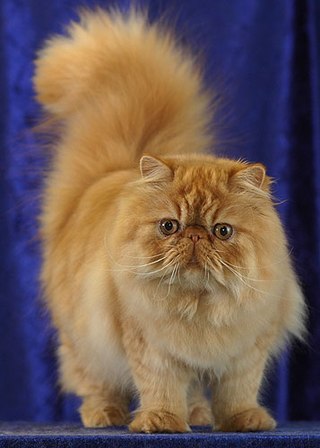
The Persian cat, also known as the Persian Longhair, is a long-haired breed of cat characterised by a round face and short muzzle. The first documented ancestors of Persian cats might have been imported into Italy from Khorasan as early as around 1620, however, this has not been proven. Instead, there is stronger evidence for a longhaired cat breed being exported from Iran/Persia from the 19th century onwards. Persian cats have been widely recognised by the North-West European cat fancy since the 19th century, and after World War II by breeders from North America, Australia and New Zealand. Some cat fancier organisations' breed standards subsume the Himalayan and Exotic Shorthair as variants of this breed, while others generally treat them as separate breeds.




